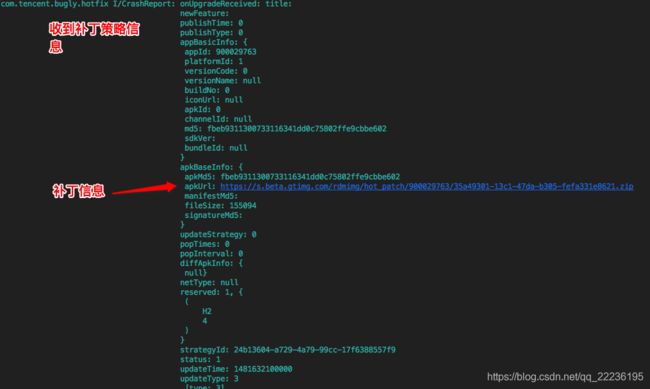bugly如何配置和打补丁包
第一步:添加插件依赖
工程根目录下“build.gradle”文件中添加:
buildscript {
repositories {
jcenter()
}
dependencies {
// tinkersupport插件, 其中lastest.release指拉取最新版本,也可以指定明确版本号,例如1.0.4
classpath "com.tencent.bugly:tinker-support:1.1.5"
}
}
第二步:集成SDK
gradle配置
在app module的“build.gradle”文件中添加(示例配置):
android {
defaultConfig {
ndk {
//设置支持的SO库架构
abiFilters 'armeabi' //, 'x86', 'armeabi-v7a', 'x86_64', 'arm64-v8a'
}
}
}
dependencies {
compile "com.android.support:multidex:1.0.1" // 多dex配置
//注释掉原有bugly的仓库
//compile 'com.tencent.bugly:crashreport:latest.release'//其中latest.release指代最新版本号,也可以指定明确的版本号,例如1.3.4
compile 'com.tencent.bugly:crashreport_upgrade:1.3.6'
// 指定tinker依赖版本(注:应用升级1.3.5版本起,不再内置tinker)
compile 'com.tencent.tinker:tinker-android-lib:1.9.9'
compile 'com.tencent.bugly:nativecrashreport:latest.release' //其中latest.release指代最新版本号,也可以指定明确的版本号,例如2.2.0
}
在app module的“build.gradle”文件中添加:
// 依赖插件脚本
apply from: 'tinker-support.gradle'
tinker-support.gradle内容如下所示(示例配置):
注:您需要在同级目录下创建tinker-support.gradle这个文件哦。

apply plugin: 'com.tencent.bugly.tinker-support'
def bakPath = file("${buildDir}/bakApk/")
/**
* 此处填写每次构建生成的基准包目录
*/
def baseApkDir = "app-1029-16-44-43"
/**
* 对于插件各参数的详细解析请参考
*/
tinkerSupport {
// 开启tinker-support插件,默认值true
enable = true
// tinkerEnable功能开关
tinkerEnable = true
// 指定归档目录,默认值当前module的子目录tinker
autoBackupApkDir = "${bakPath}"
// 是否启用覆盖tinkerPatch配置功能,默认值false
// 开启后tinkerPatch配置不生效,即无需添加tinkerPatch
overrideTinkerPatchConfiguration = true
// 编译补丁包时,必需指定基线版本的apk,默认值为空
// 如果为空,则表示不是进行补丁包的编译
// @{link tinkerPatch.oldApk }
baseApk = "${bakPath}/${baseApkDir}/app-debug.apk"
// 对应tinker插件applyMapping
baseApkProguardMapping = "${bakPath}/${baseApkDir}/app-debug-mapping.txt"
// 对应tinker插件applyResourceMapping
baseApkResourceMapping = "${bakPath}/${baseApkDir}/app-debug-R.txt"
// 构建基准包跟补丁包都要修改tinkerId,主要用于区分
tinkerId = "base-1.0.6"
// 打多渠道补丁时指定目录
// buildAllFlavorsDir = "${bakPath}/${baseApkDir}"
enableProxyApplication = true
}
/**
* 一般来说,我们无需对下面的参数做任何的修改
* 对于各参数的详细介绍请参考:
* https://github.com/Tencent/tinker/wiki/Tinker-%E6%8E%A5%E5%85%A5%E6%8C%87%E5%8D%97
*/
tinkerPatch {
tinkerEnable = true
ignoreWarning = false
useSign = true
dex {
dexMode = "jar"
pattern = ["classes*.dex"]
loader = []
}
lib {
pattern = ["lib/*/*.so"]
}
res {
pattern = ["res/*", "r/*", "assets/*", "resources.arsc", "AndroidManifest.xml"]
ignoreChange = []
largeModSize = 100
}
packageConfig {
}
sevenZip {
zipArtifact = "com.tencent.mm:SevenZip:1.1.10"
// path = "/usr/local/bin/7za"
}
buildConfig {
keepDexApply = false
// tinkerId = "base-2.0.1"
}
}
第三步:初始化SDK
这是Tinker推荐的接入方式,一定程度上会增加接入成本,但具有更好的兼容性。
集成Bugly升级SDK之后,我们需要按照以下方式自定义ApplicationLike来实现Application的代码(以下是示例):
自定义Application
public class SampleApplication extends TinkerApplication {
public SampleApplication() {
super(ShareConstants.TINKER_ENABLE_ALL, "xxx.xxx.SampleApplicationLike",
"com.tencent.tinker.loader.TinkerLoader", false);
}
}
自定义ApplicationLike
public class SampleApplicationLike extends DefaultApplicationLike {
public static final String TAG = "Tinker.SampleApplicationLike";
public SampleApplicationLike(Application application, int tinkerFlags,
boolean tinkerLoadVerifyFlag, long applicationStartElapsedTime,
long applicationStartMillisTime, Intent tinkerResultIntent) {
super(application, tinkerFlags, tinkerLoadVerifyFlag, applicationStartElapsedTime, applicationStartMillisTime, tinkerResultIntent);
}
@Override
public void onCreate() {
super.onCreate();
// 这里实现SDK初始化,appId替换成你的在Bugly平台申请的appId
// 调试时,将第三个参数改为true
Bugly.init(getApplication(), "900029763", false);
}
@TargetApi(Build.VERSION_CODES.ICE_CREAM_SANDWICH)
@Override
public void onBaseContextAttached(Context base) {
super.onBaseContextAttached(base);
// you must install multiDex whatever tinker is installed!
MultiDex.install(base);
// 安装tinker
// TinkerManager.installTinker(this); 替换成下面Bugly提供的方法
Beta.installTinker(this);
}
@TargetApi(Build.VERSION_CODES.ICE_CREAM_SANDWICH)
public void registerActivityLifecycleCallback(Application.ActivityLifecycleCallbacks callbacks) {
getApplication().registerActivityLifecycleCallbacks(callbacks);
}
}
第四步:AndroidManifest.xml配置
在AndroidMainfest.xml中进行以下配置:
1. 权限配置
2. Activity配置
3. 配置FileProvider
注意:
如果您想兼容Android N或者以上的设备,必须要在AndroidManifest.xml文件中配置FileProvider来访问共享路径的文件。
如果你使用的第三方库也配置了同样的FileProvider, 可以通过继承FileProvider类来解决合并冲突的问题,示例如下:
这里要注意一下,FileProvider类是在support-v4包中的,检查你的工程是否引入该类库。
在res目录新建xml文件夹,创建provider_paths.xml文件如下:
第五步:混淆配置
为了避免混淆SDK,在Proguard混淆文件中增加以下配置:
-dontwarn com.tencent.bugly.**
-keep public class com.tencent.bugly.**{*;}
# tinker混淆规则
-dontwarn com.tencent.tinker.**
-keep class com.tencent.tinker.** { *; }
如果你使用了support-v4包,你还需要配置以下混淆规则:
-keep class android.support.**{*;}
补丁包









